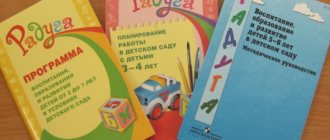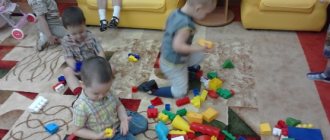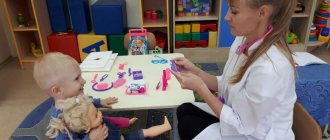Soviet teacher Vasily Sukhomlinsky said: “Without chess it is impossible to imagine the full education of mental abilities and memory.” And these are not just words: research results show that children who play chess show a higher level of intellectual development.
Playing chess develops:
- ability to reason;
- logic;
- problem solving ability;
- perseverance;
- patience;
- attention;
- memory.
During the game, both hemispheres of the brain work, which increases the ability to think outside the box. Also worth noting is the ability to lose correctly and the desire to win.
When should you start teaching children to play chess?
Of course, it all depends on the child. But, as practice shows, a child at the age of four can already easily master the rules of this game.
How to get your baby interested in playing?
Children love to play and each child has their own favorite games. Offer your child a new game. If she interests him, then great. If not, then try suggesting it after some time, when the baby is a little older.
Play with each other in the presence of the baby. Perhaps the child will be interested in the game and want to try it.
Chess: rules for beginner children
The first lesson begins with an introduction to figures. The baby needs to remember their names. Perhaps he will want to play with the chess pieces as he pleases. Let him do it. If your child likes to fantasize, then you can come up with a fairy tale about a chess country.
the second lesson to telling your child that each piece has a position on the board and the pieces move according to certain rules:
The pawn takes only one step forward on the plane of the board, and eats the enemy piece diagonally. Also, a pawn is promoted to any piece if it manages to reach the opposite edge of the board.
The king can also take one step , although in any direction.
The queen is the most powerful in the entire game. Moves straight, sideways, and diagonally.
The knight has an unusual move: it jumps over the other figures two squares and one sideways. His move is similar to the letter "G".
The bishop moves diagonally the required number of squares.
Rook forward or sideways.
All pieces are removed from the board, and the king cannot be eaten. You can only declare checkmate.
You can devote a separate lesson to each. Then show how they work in conjunction with each other. If the baby is tired, then there is no need to insist on the lesson. This can discourage you from playing the game forever.
Take your time and accompany your learning of the rules with various games:
- Wonderful bag. Hide all the chess pieces in an opaque bag one by one and ask the child to determine by touch which piece you have hidden. For greater effect, let your baby hide the pieces and guess which chess piece is in the bag.
- "Find differences". Ask your child to list all the differences between one figure and another.
- "What's missing." You place all the representatives of the chess pieces on the table and, when the child turns away, you remove one piece. The kid must guess which figure you hid. This game perfectly develops visual memory.
- Modeling chess pieces from plasticine or clay.
- "Cube". Take one of the old cubes, draw each of the six chess pieces on paper, and glue the designs to the faces of the cube. Or glue a cube from whatman paper. Throw the dice one at a time. The thrower must name the figure that appears on the top face of the die.
- "Guessing game." Verbally describe a chess piece to your child and ask him to guess what kind of piece it is. Then switch roles.
- "Forbidden figure" Place the chess pieces in front of the child in one row. At your request, the baby will name all the shown figures, except for the “forbidden” one, which is selected in advance. Instead of naming the forbidden figure, you should say: “Secret.”
- “Let’s play and guess.” Wish your child a chess piece. The kid lists the figures until he names the one he has in mind. Then switch roles.
- "Letter". Ask your child which chess pieces have names that begin with the letters K, L, P, C, F.
- "What common?". Take any two chess pieces and ask your child: how are they similar? What is the difference? (Color, shape).
- "Big and small." Place six different chess pieces in front of your child, ask them to choose the tallest one, name it and set it aside. Then the child will determine the tallest of the remaining figures, etc. At the end of the game, all chess pieces are returned to their place, and a new game begins, in which the lowest chess piece is chosen.
- "Chess house". Build a little house out of cubes, into which the chess pieces will run one at a time, from the smallest to the largest. The child must name each of them.
- "Chess turnip" Plant a turnip. Next to her, the child lines up chess pieces according to their height, explaining: “Grandfather is a king, grandmother is a queen, granddaughter is a bishop, a bug is a knight, a cat is a rook, a mouse is a pawn.”
- "Chess bun". A didactic game-dramatization of the fairy tale “Kolobok” can be played like this: the grandfather is the king, the woman is the queen, the hare is the pawn, the fox is the knight, the wolf is the elephant, the bear is the rook, and the bun is a ball or ball. The child must name all the chess pieces from which the bun is running away. At the end of the fairy tale, let the fox not eat the bun, the bun will run away from it.
- "White and Black." Place six different white and black chess pieces on the table in disarray. When starting a didactic game, set one of the figures aside, naming it and indicating its color, for example: “White horse.” The child continues the game and chooses a chess piece of a different name and color (this is the condition), always calling it, for example: “Black Queen.” Next, you introduce a new chess piece, etc.
- "School". Turn the wooden chessboard over with the squares down, place chess pieces in the recesses and tell the child: “These are your students. What is this student's name? And this? And this?. ."
- "Color". Ask your child to place all white or all black chess pieces in one row. When the child completes the task, switch roles and, for example, placing white pieces next to each other, “by mistake” place one or two black chess pieces there. The child should notice your mistake and point it out.
- "Pyramid". Advise your child to place a black one on the white rook, then again white and black, and on the very top - the white king. Ask your child if it is possible to build a pyramid using other chess pieces.
- "Catching up." Select one of the white pieces, for example a queen, and imitate it running across the table. After this, invite the child to choose and name a black piece and set off after your queen. Let your chess piece not “run” very fast, and the child’s piece will catch up with it. Then switch roles.
- "Hide and seek." Hide several chess pieces in the room. The child must find and name them. In this didactic game, unlike others, it is very dangerous to change roles, as you risk being left with an incomplete set of chess pieces.
- "Over your head." Name some chess piece. The child must select it and raise it above his head.
- "On the chair". Place one of the chess pieces on the chair. Stand on opposite sides of the chair, but at an equal distance from it, with the child. Count to three and on the count of three, run to the chair. The first one to grab a chess piece must name it.
- “Take the same one away.” All chess pieces stand or lie on the table. Put one of the figures into the box. Ask your child to name this piece and put another similar chess piece in the box, etc.
- "The room is full." A complete set of chess pieces is placed on the table. Nearby, with the fields facing down, lies an open wooden chessboard or box for chess pieces. Invite your child to take one of the chess pieces, name it and put it to “sleep” in a box or chessboard. The next figure is laid out by you. And so on until all the chess pieces are in the box. After this, the child closes the box or latches the chessboard.
The last two educational games are designed to make the process of collecting chess pieces after the end of the lesson quite entertaining.
In the third lesson, work with your child on the correct placement of the figures and the simplest steps of each figure from memory.
Once he remembers where their place is on the board, you can teach the rules of the game step by step. A little chess player must understand the basic principles :
- Always provide cover for your king.
- Game characters can only be eaten if they are sacrificed in favor of a successful move.
- The weaker the figure, the closer to the center it should stand.
- The value of the pieces is different: a rook is more valuable than a pawn, and the king, although influential, is helpless.
- It is advisable to be the first to neutralize the enemy queen.
To maintain interest in the game and improve your child’s skills, there are several recommendations from chess school teachers:
- Winning the game will be an incentive, but you shouldn’t give in to your child often, otherwise he will decide that there is no need to study further.
- Play only when the child has a desire.
- The preparatory stage for playing chess can be practicing checkers.
- It is useful after the game to discuss its progress, what mistakes were made, and what actions were successful.
- Buy a book with chess problems for children.
- It is necessary to celebrate the child’s successes and praise them for successful moves.
Teach your children to play chess. I hope that the tips on how to conduct your child’s first chess lessons will help you get your child interested in this wonderful and very useful game.
You can also find a wonderful illustrated book for children for yourself
F. Halas, Z. Getsi “Adventures in the chess kingdom.” Good luck!
Game technique
- Instill interest.
In this case, there are several ways, but for a preschool child, the most comprehensive will be the “forbidden fruit” method. If children are prohibited from doing something, they will definitely become interested in it. Several such situations and the child will definitely be ready to sit for more than one hour with a forbidden toy.
- Rules of the game.
The rules of chess are quite complex, but if presented correctly, children will be able to understand and remember them. You should not burden your child with abstruse chess terms. It is unlikely that they will use castling or suffer from zugzwang, much less play rapid with a Fischer clock. It is enough to explain how the pieces move, what the goal of the game is; indicate the ranks of the figures and their roles.
Interest in chess
- Use of support resources.
Chess with an adult for preschoolers helps them learn all the intricacies of the game. You can already deepen your knowledge, look at legendary chess studies, watch videos with comments, use illustrated literature, etc.
Additional Information! It would not be superfluous to introduce new terms of the chess game, which should be revealed to the child gradually. Using new “chess” words creates a desire to learn more about the game.
Have some fun
At the very beginning, it is important not to “overload” the child with rules and terms. Play and have fun! For example, a child can use pieces to collect candy on a chessboard or play mazes to remember the moves of the pieces.
Here are a couple more interesting techniques:
- Let's imagine that the chessboard is a battlefield. This means that each “fighter” must have his own function: the pawns are foot soldiers, the king is the general of the entire army.
- Imagine that your bishop is a knight who must get to the queen’s castle through obstacles (opponent’s pieces). What's the best way to do this?
Imagine with your child and have fun in the process!
Chess lessons at preschool educational institutions
- Preparatory stage. You can ask parents to talk about chess, how one of their relatives participated in a tournament, offer to read or watch a chess tutorial for children together, or take the child to a place where grandmasters gather. If children get an idea about chess, they can become interested in it.
- Organization of an open chess lesson. You can teach children to draw chess boards in notebooks, recognize pieces, explain what diagonal, horizontal and vertical are. Then you should tell how each figure walks, using diagrams. Rhymes, riddles and songs will help with this.
- Repetition is the mother of learning. After a lesson in the basics of chess, children will remember only part of what they heard, and to consolidate the result, they need to conduct another quest lesson. The child is asked to remember what was said, but in a way that makes it interesting. The presence of parents is welcomed, as the child can boast of his knowledge, and parental approval will consolidate the result. Chess develops not only logic, but also creativity.
Chess play
Advice! Guys and girls can act as figures themselves, because in a team everyone always has their own role: there are princesses, kings, officers and pawns. Do not label, but explain that each figure has a special meaning and plays an extremely important role.
Drawings on the topic “Children doing exercises” in older groups of preschool educational institutions
Children can be taught chess from preschool age. It develops creativity, logical thinking and allows the brain to work at full strength. Comprehensive teaching of chess to children – in the family circle and in a preschool educational institution – will strengthen the child’s desire to practice and will make it possible to understand that chess broadens one’s horizons, introduces one to new friends and gives priority in the team.






